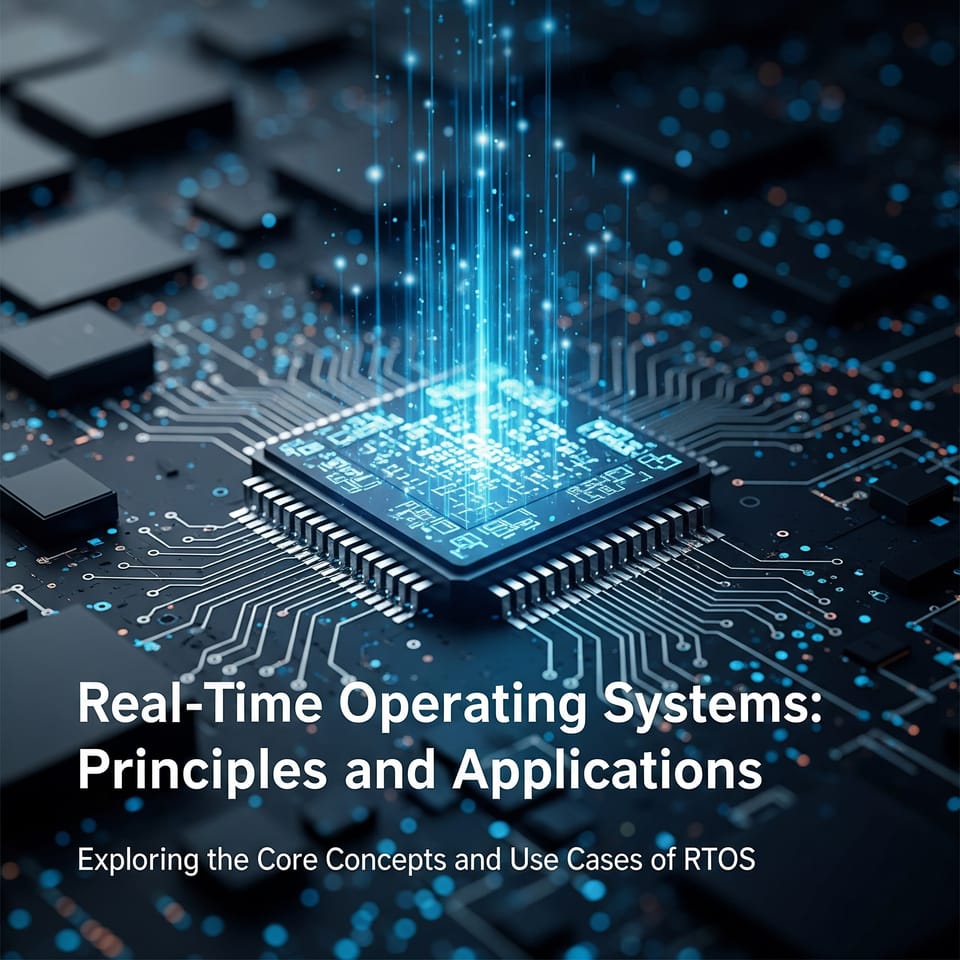Real-Time Operating Systems (RTOS): What Are They and Why Do They Matter?

Many of the devices that touch our daily lives – whether it's a smartwatch, a drone, or the control unit inside a car – operate on complex software behind the scenes. Most of these systems are racing against time. They need to perform specific tasks at just the right moment. That’s where Real-Time Operating Systems, or RTOS, come in.
What Is an RTOS?
An RTOS (Real-Time Operating System) is a specialized operating system designed to run tasks within specific time intervals. Unlike general-purpose operating systems, an RTOS ensures that a task is performed "within this amount of time." It provides predictable scheduling, making it ideal for time-sensitive applications.
Core Features of RTOS
RTOSes don’t execute tasks randomly. They operate based on priority and never waste time. If a task is more urgent than another, it can interrupt and take over. This behavior is known as "preemptive multitasking." RTOSes also provide mechanisms like queues, message boxes, and semaphores for safe communication between tasks.
They also use highly precise timers, so you can say, "start this task exactly 5 milliseconds later," and it will.
Where Are RTOSes Used?
RTOS is indispensable in systems where timing is critical. Examples include:
- Automotive control systems (engine, braking, etc.)
- Industrial robots and automation lines
- Medical devices (such as heart rate monitors)
- Avionics systems like autopilot
- Smart home products, IoT devices, drones...
Basically, if a device has a processor and timing is important, there's likely an RTOS involved.

Differences Between RTOS and General-Purpose Operating Systems
There’s a big difference between RTOS and general-purpose OSes like Windows or Linux. While RTOS guarantees tasks are completed on time, Linux and Windows are more relaxed in that regard.
| Feature | RTOS | General Purpose OS (Windows/Linux) |
|---|---|---|
| Scheduling | Deterministic | Variable |
| Boot Time | Very short | Relatively long |
| Memory Usage | Minimal | Higher |
| Priority Management | Strict and precise | Relatively loose |
| Use Case | Embedded systems | Desktops, mobile, servers |
Popular RTOS Examples
There are many RTOS options today. Here are some of the most well-known:
- FreeRTOS: Open source and backed by Amazon.
- Zephyr: Linux Foundation-backed, ideal for IoT.
- VxWorks: Commercial RTOS widely used in industry.
- RTEMS: Used in aerospace and defense applications.
- Micrium uC/OS: Common in medical and automotive sectors.
Why Should You Use an RTOS?
The primary reason to use an RTOS is its ability to execute tasks on time and predictably. Imagine a heart-monitoring device that delays a reading by even one second – the consequences could be serious. RTOS minimizes such latency in critical systems.
RTOSes also manage resources efficiently. Even on constrained hardware, they perform reliably. Because tasks are executed based on priority, the system always focuses on the most important work. This boosts both security and performance.
For developers, RTOS brings simplicity. Software components can be written, tested, and integrated independently. This modularity makes maintenance easier and speeds up development. So, if you’re building a time-sensitive system, RTOS could be your best ally.
What It's Like to Develop on an RTOS
Developing software on an RTOS is quite different from working with general-purpose systems like Windows or Linux. The key differences lie in timing, resource management, and reliability.
Task-Based Design and Scheduling
Instead of a single main loop, RTOS applications are split into independent tasks, each with a specific purpose. The RTOS kernel manages these tasks based on their assigned priorities. Priority management is crucial because higher-priority tasks can interrupt lower-priority ones. Since tasks must often meet specific deadlines, determinism and time-awareness are vital throughout your design.
Inter-Task Communication and Synchronization
Multiple tasks may try to access shared data or hardware. This can cause race conditions and data corruption. RTOSes provide synchronization tools to handle this:
- Semaphores: To manage access to shared resources or to signal between tasks.
- Mutexes: Ensure that only one task at a time can enter a critical section.
- Message Queues: Allow tasks to send data to each other safely.
- Event Flags/Signals: Let tasks signal the occurrence of events.
Proper use of these tools is essential to avoid deadlocks and priority inversions.
Memory Management
RTOSes are often used in systems with limited memory and processing power. As a result, memory usage must be carefully controlled. Dynamic memory allocation (e.g., malloc, free) can cause fragmentation and unpredictable delays. Therefore, static memory allocation or memory pools provided by the RTOS are usually preferred. Each task has its own stack, so correctly sizing each stack is also critical to avoid overflows.
Hardware Access and Interrupts
RTOS-based applications frequently interact directly with hardware, which requires low-level programming skills. Interrupts are used to respond quickly to external events. ISR (Interrupt Service Routine) code should be short and efficient. Long tasks should be deferred to regular tasks via signaling mechanisms. Interrupt latency of the RTOS is also an important performance metric.
Debugging and Testing
Bugs in RTOS applications often stem from timing, task synchronization, or resource sharing. RTOSes often come with dedicated debugging tools that help monitor task states, queues, semaphores, and more. In-circuit debuggers or emulators are frequently used. Extensive testing under various loads and scenarios is a must for critical systems.
Reliability and Fault Tolerance
In critical systems, fault tolerance is essential. Mechanisms like watchdog timers automatically reset the system if it crashes or hangs. These mechanisms ensure the system either continues working or shuts down safely when something goes wrong.
Real-time operating systems are quietly running behind many of the systems we rely on – in our cars, our watches, hospitals, factories, and more. If you're developing a time-critical system or looking to enter the embedded world, learning RTOS will give you a significant edge. It might seem complex at first, but once you see how controlled and powerful the system becomes, you'll find yourself saying, "I'm glad I used an RTOS."